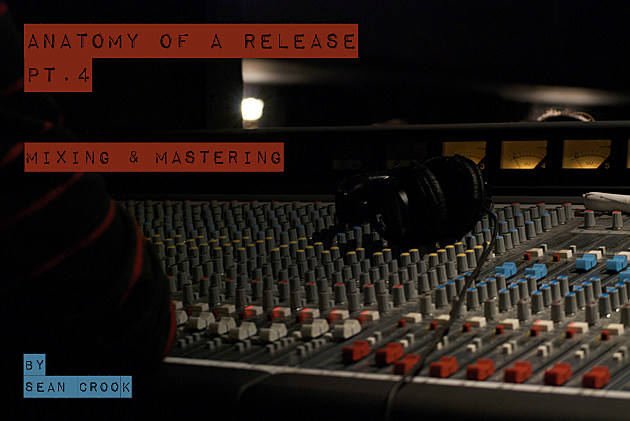
Anatomy of a Release, Pt. 4: Mixing & Mastering
. . .
The series “Anatomy of a Release” will track the progress of a release from start to finish. Part 1 covered signing the band. Part 2 covered recording the album. Part 3 covered album artwork. In this fourth installment, Sean Crook, label head of The Path Less Traveled Records, talks about mixing and mastering.
. . .
ANATOMY OF A RELEASE
PT. 4
MIXING & MASTERING
. . .
Greetings, friends! It’s been a little bit since we last met. When we last left you, we had the art, the CD, and all of the guts to send the CD off for printing. This time around, we’re going to focus on a topic that may be boring to some. But to others, it will probably generate a lot of talk (especially for you musicians)! Since we started these blog posts about Kaliya, there has been a lot of chatter about pre-production, post-production, mixing, mastering, etc. Like a lot of folks, I didn’t really know what any of it meant (and to some degree still don’t). We will try to walk you through the process on how this all works, some samples to show you how mixing and mastering aren’t the same, and how these are sometimes the hardest parts of getting a record put together.
I liken it to having a group of five folks and ordering pizza. Ever tried this? Once you spend half an hour deciding who will order it, you have to debate on the size, what toppings, how many pizzas, etc. Then you have to debate on where to get the pizza and, ultimately, who will pay for the pizza. It’s never as easy as ordering five large pepperonis and being done. Recording a CD is very similar. Getting five people to create a piece of art and agree on every aspect of it all the way through recording, mixing, and mastering is a chore. You get together, decide you want to make music (pizza), how many tracks you want to use (toppings), who will mix and master (where you order your pizza), and how you will pay for it (same for pizza and mixing/mastering). More drums, less bass, more vocals, more guitar, argue and walk away, less drums, etc. These things eat up time and money, and it’s usually where bands tend to argue the most. Mastering is where you can make drums bigger, guitars louder, and egos smaller.
I’ll let Ben from Kaliya talk about the process they went through.
. . .
So for the mixing of the album, we used the same guy that engineered all the tracks that we recorded. I know some bands have been known to record with one guy, have another guy mix it, and then another master it. We chose to have our engineer doing the mixing as well. In my opinion, the mixing process is one of – if not the most – important parts of the recording process. We went through probably 5-6 mixes before arriving at the final version that we chose to have mastered. Probably the most difficult part of this process was getting each member happy with where his part fit in the mix. As I said in an earlier post, guitar players want more guitar, drummers want more drums, etc. Eventually, though, we arrived at a mix that everyone seemed happy with. Once we were done with this process, we definitely wanted to have a second set of ears master the album.Mixing is adjusting the overall tonality of each microphone recording each instrument. For our recording process, there were 3-5 guitar tracks on each song, 3-5 vocal tracks, a bass track, and probably only God knows how many drum tracks/microphones. Adjusting the tone that is recorded on each of these tracks and the volumes/layers on where they sit in the overall sound of the album is essentially what occurs in the mixing process. Is there enough high end in the guitar? Should it sit above or behind the drums? Do the vocals have enough delay in this part? Are the high hats too crisp? These are all questions that are answered or addressed in the mixing process. We would tweak a few of these settings with each version of the final mix until we felt happy with them. Each new mix you listen to at home, in your car, on your iPod or wherever you can think to hear how it sounds on each.
Absu’s Proscriptor McGovern was a name that some friends had mentioned to us as a great person to use for mastering. We wanted to have someone “metal” listen to it and add their touch. The mastering process essentially mashes everything together, adds some beef to it, and raises the levels on the overall sound of the album. Compared to the cost of recording and mixing, it is relatively inexpensive and makes a very significant difference. The mastering process finally made the album sound “legit”. It really brought out the low end crush that we were looking for and brought up the levels to make the album jump out at the listener.
I would say mastering is the ultra-fine tuning of the overall EQ of the album once all the instruments have been combined into one master track. Once the mixing process is completed, there is no adjustment to individual guitar tone, vocal tone, drum tone, etc. There can be modifications made to the overall EQ that may bring out one of those elements, but it is only by coincidence. With our album, we just wanted it loud and heavy (imagine that, haha). Proscriptor was able to accomplish this by dialing in the EQ in a way that it really brought some meat to the album. He was also able to touch up a couple pieces in terms of track transition and other things that may have been overlooked in the mixing/recording process.
Mastering, from what I can tell, is a less involved process when compared to mixing. There are adjustments that can be made, but you are really only dealing with one track, whereas with mixing there are adjustments that can be made to an infinite number of tracks.
. . .
This album’s mastering engineer
. . .
We could probably write a short novel on the first paragraph. If touring is the main reason bands break up, I can guarantee recording, mixing, and mastering are a close second. I put in bold two very important points. The mixing is very important, and having another set of ears listen is also extremely important. Try to get someone who knows what they’re doing. There’s a reason folks like a guy like Proscriptor (who no longer masters records) and Scott Hull. They’re metal guys and know what they’re doing. The average cost is about $500, depending on how much work goes into it, how many songs and how long they are, and how picky the band gets.
I know very little about recording but thought I should learn. For those that want to know more, there’s a free magazine called Tape Op Magazine. You’ll know more about gear, mastering, mixing, and recording then you ever dreamed of, and it’s free! Kurt Ballou, Chris Owens (Lords), and many other metal and non-metal folks are featured, and it’s an easy read. I highly recommend this magazine if you’re in the recording aspect of music. If nothing else, it’s quite an eye-opener on what bands go through to record music.
Lord (or Satan, if you prefer) only knows how many times Kaliya have played these songs live. Then they had to play them over and over in the studio and then LISTEN to the songs over and over. It’s enough to drive anyone mad. Then to top it off, their label owner ran into an entity called the IRS (long story) which delayed the production of the CD.
We’ll probably have one more post before the release date of August 30, 2011 where I’ll try to dig into the money aspect from a distribution standpoint. It might help explain why a CD only costs $0.80 to make, but usually runs $8 – $10, and how Best Buy can sell a CD for $5.99, but Borders has the same CD for $18.99.
Thanks again for reading, and especially for providing feedback!
The Path Less Traveled Records
Mixing board photo by Wikimania2009
. . .
KALIYA – MIXING & MASTERING EXAMPLES
“Chicanery” (pre-production)
[audio: KALIYA_CHICANERY(PREPROD).mp3]
“Chicanery” (unmastered)
[audio: KALIYA_CHICANERY(UNMASTERED).mp3]
“Chicanery” (mastered)
[audio: KALIYA_CHICANERY(MASTERED).mp3]
. . .
KALIYA LINKS
MySpace
Facebook
The Path Less Traveled Records
. . .












